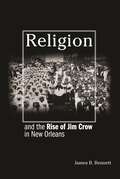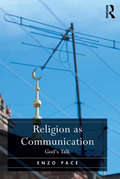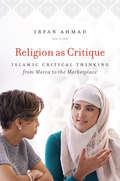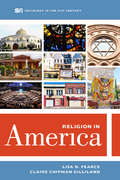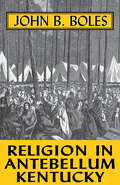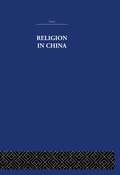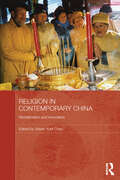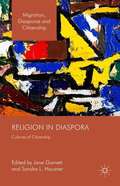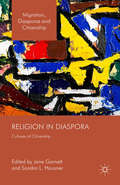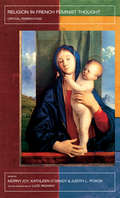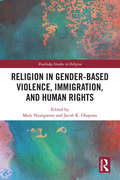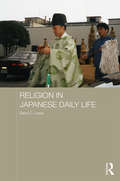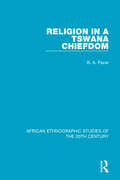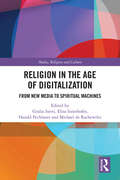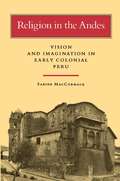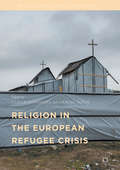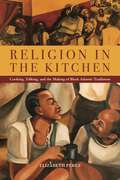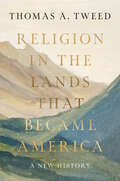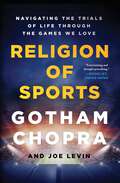- Table View
- List View
Religion and the Rise of Jim Crow in New Orleans
by James B. BennettReligion and the Rise of Jim Crow in New Orleans examines a difficult chapter in American religious history: the story of race prejudice in American Christianity. Focusing on the largest city in the late-nineteenth-century South, it explores the relationship between churches--black and white, Protestant and Catholic--and the emergence of the Jim Crow laws, statutes that created a racial caste system in the American South. The book fills a gap in the scholarship on religion and race in the crucial decades between the end of Reconstruction and the eve of the Civil Rights movement. Drawing on a range of local and personal accounts from the post-Reconstruction period, newspapers, and church records, Bennett's analysis challenges the assumption that churches fell into fixed patterns of segregation without a fight. In sacred no less than secular spheres, establishing Jim Crow constituted a long, slow, and complicated journey that extended well into the twentieth century. Churches remained a source of hope and a means of resistance against segregation, rather than a retreat from racial oppression. Especially in the decade after Reconstruction, churches offered the possibility of creating a common identity that privileged religious over racial status, a pattern that black church members hoped would transfer to a national American identity transcending racial differences. Religion thus becomes a lens to reconsider patterns for racial interaction throughout Southern society. By tracing the contours of that hopeful yet ultimately tragic journey, this book reveals the complex and mutually influential relationship between church and society in the American South, placing churches at the center of the nation's racial struggles.
Religion and the Subtle Body in Asia and the West: Between Mind and Body
by Geoffrey Samuel Jay JohnstonSubtle-body practices are found particularly in Indian, Indo-Tibetan and East Asian societies, but have become increasingly familiar in Western societies, especially through the various healing and yogic techniques and exercises associated with them. This book explores subtle-body practices from a variety of perspectives, and includes both studies of these practices in Asian and Western contexts. The book discusses how subtle-body practices assume a quasi-material level of human existence that is intermediate between conventional concepts of body and mind. Often, this level is conceived of in terms of an invisible structure of channels, associated with the human body, through which flows of quasi-material substance take place. Contributors look at how subtle-body concepts form the basic explanatory structure for a wide range of practices. These include forms of healing, modes of exercise and martial arts as well as religious practices aimed at the refinement and transformation of the human mindbody complex. By highlighting how subtle-body practices of many kinds have been introduced into Western societies in recent years, the book explores the possibilities for new models of understanding which these concepts open up. It is a useful contribution to studies on Asian Religion and Philosophy.
Religion as Communication: God's Talk
by Enzo PaceWhy do Gods persist in contemporary society? Religious revival and vitality all over the world contradict the vision of continuing declining of belief. This linear process of eclipse of the sacred in modern society has been proved wrong. Religion indeed is an expert system competent in ultimate meanings of human being and social order. Enzo Pace argues that religion persists as a symbol because of its intrinsic power of communication, in its will to wield the power to dominate the event of death, and to build a bridge between the visible and the invisible. The crucial passage from living word to holy scripture is a fundamental device in the construction of a system of religious belief. This book provides an insight on a new approach to religious studies, drawing from systems theory to consider religion as a means of communication, and offering a critical alternative to the secularization theory to explain why religion persists in modernity.
Religion as Critique: Islamic Critical Thinking from Mecca to the Marketplace (Islamic Civilization and Muslim Networks)
by Irfan AhmadIrfan Ahmad makes the far-reaching argument that potent systems and modes for self-critique as well as critique of others are inherent in Islam--indeed, critique is integral to its fundamental tenets and practices. Challenging common views of Islam as hostile to critical thinking, Ahmad delineates thriving traditions of critique in Islamic culture, focusing in large part on South Asian traditions. Ahmad interrogates Greek and Enlightenment notions of reason and critique, and he notes how they are invoked in relation to "others," including Muslims. Drafting an alternative genealogy of critique in Islam, Ahmad reads religious teachings and texts, drawing on sources in Hindi, Urdu, Farsi, and English, and demonstrates how they serve as expressions of critique. Throughout, he depicts Islam as an agent, not an object, of critique.On a broader level, Ahmad expands the idea of critique itself. Drawing on his fieldwork among marketplace hawkers in Delhi and Aligarh, he construes critique anthropologically as a sociocultural activity in the everyday lives of ordinary Muslims, beyond the world of intellectuals. Religion as Critique allows space for new theoretical considerations of modernity and change, taking on such salient issues as nationhood, women's equality, the state, culture, democracy, and secularism.
Religion at Work in a Neolithic Society
by Ian HodderThis book tackles the topic of religion, a broad subject exciting renewed interest across the social and historical sciences. The volume is tightly focused on the early farming village of Çatalhöyük, which has generated much interest both within and outside of archaeology, especially for its contributions to the understanding of early religion. The volume discusses contemporary themes such as materiality, animism, object vitality, and material dimensions of spirituality while at the same time exploring broad evolutionary changes in the ways in which religion has influenced society. The volume results from a unique collaboration between an archaeological team and a range of specialists in ritual and religion.
Religion by Radio: Its Place in British Broadcasting (Routledge Library Editions: Radio #2)
by Melville DinwiddieThis book, first published in 1968, describes the development of religion by radio, and its influences on people both inside and outside the Church. It tells of experiment and practice, of acceptance and rejection, of inspiration and comfort in peace and war, and assesses the great contribution made by religion to British broadcasting over the decades since the first religious broadcast, on Christmas Eve of 1922.
Religion in America (Sociology in the Twenty-First Century #6)
by Lisa D. Pearce Claire Chipman GillilandWritten in an engaging and accessible tone, Religion in America probes the dynamics of recent American religious beliefs and behaviors. Charting trends over time using demographic data, this book examines how patterns of religious affiliation, service attendance, and prayer vary by race and ethnicity, social class, and gender. The authors identify demographic processes such as birth, death, and migration, as well as changes in education, employment, and families, as central to why some individuals and congregations experience change in religious practices and beliefs while others hold steady. Religion in America challenges students to examine the demographic data alongside everyday accounts of how religion is experienced differently across social groups to better understand the role that religion plays in the lives of Americans today and how that is changing.
Religion in Antebellum Kentucky
by John B. BolesA look at the Christian religions in the Bluegrass State before the Civil War from the author of the acclaimed Jefferson: Architect of American Liberty.Religion permeated the day-to-day life of antebellum Kentucky. This engaging account of Kentucky’s various Christian denominations, first published as part of the Kentucky Bicentennial Bookshelf, traces the history of the Great Revival of 1800–1805, the subsequent schism in Protestant ranks, the rise of Catholicism, the development of a distinctive black Christianity, and the growth of a Christian antislavery tradition.Paying special attention to the role of religion in the everyday life of early Kentuckians and their heritage, John B. Boles provides a concise yet enlightening introduction to the faith and the people of the Bluegrass State. Religion in Antebellum Kentucky is an excellent survey of religion and its significance in the first eighty-five years of Kentucky’s history.“A small historical gem . . . Boles has set an admirable standard of excellence for this sort of study.” —William and Mary Quarterly
Religion in China
by K. Hughes E. R. HughesFirst published in 1950.Beginning with ancient times, this volume shows how some of the early superstitions became purified through the influence of the Confucianist philosophy, how a deep strain of mysticism came from the Taoists and how thereby a worship of 'Heaven' and 'Earth' was evolved. Besides the main streams of Confucianism and Buddhism, the introduction and development of Christianity into China is also analyzed.
Religion in China: A Brief Account of the Three Religions of the Chinese
by Joseph EdkinsFirst Published in 2000. Routledge is an imprint of Taylor & Francis, an informa company.
Religion in Contemporary China: Revitalization and Innovation (Routledge Contemporary China Series)
by Adam Yuet ChauBefore the modernist transformations of the twentieth century, China had one of the richest and most diverse religious cultures in the world. The radical anti-traditionalist policies of both the Republican and Communist regimes as well as other socio-historical factors posed formidable challenges to China’s religious traditions but, this book argues, these conditions also presented new opportunities for re-generation and innovation. It shows that economic reforms and the concurrent relaxation of religious policies have provided fertile ground for the revitalization of a wide array of religious practices, including divination, ancestor worship, temple festivals, spirit mediumism, churchgoing, funeral rites, exorcism, pilgrimages, sectarianism, sutra chanting, and the printing and distribution of morality books. Equally new forms of religious practices have emerged such as lay Buddhist preachers, "Maoist shamans", and a range of qigong sects/schools. Written by an international, interdisciplinary team of experts who have all conducted in-depth fieldwork research in China, this book provides a wide-ranging survey of contemporary religious practices in China. It examines the different processes and mechanisms of religious revivals and innovations, and, more broadly, relates the Chinese example of religious revitalization to larger issues of social and cultural continuity and change.
Religion in Diaspora: Cultures of Citizenship (Migration, Diasporas and Citizenship)
by Sondra L. Hausner Jane GarnettThis edited collection addresses the relationship between diaspora, religion and the politics of identity in the modern world. It illuminates religious understandings of citizenship, association and civil society, and situates them historically within diverse cultures of memory and state traditions.
Religion in Diaspora: Cultures of Citizenship (Migration, Diasporas and Citizenship)
by Sondra L. Hausner Jane GarnettThis edited collection addresses the relationship between diaspora, religion and the politics of identity in the modern world. It illuminates religious understandings of citizenship, association and civil society, and situates them historically within diverse cultures of memory and state traditions.
Religion in French Feminist Thought: Critical Perspectives
by Morny Joy Kathleen O’Grady Judith L. PoxonReligion in French Feminist Thought: Critical Perspectives brings together some of the leading modern religious responses to major French feminist writings on religion. It considers central figures such as Hélène Cixous, Julia Kristeva, Luce Irigaray and Catherine Clément, and its focus on questions of divinity, subjectivity, and ethics provides an accessible introduction to an area of growing philosophical interest.Illustrating the ways in which French feminism has become a valuable tool in feminist efforts to rethink religion, and responding to its promise as an intellectual resource for religious philosophy in the future, Religion in French Feminist Thought is ideal both for independent use and as a companion book to French Feminists on Religion (Routledge, 2001).
Religion in Gender-Based Violence, Immigration, and Human Rights (Routledge Studies in Religion)
by Jacob K. Olupona Mary NyangwesoThis book builds on work that examines the interactions between immigration and gender-based violence, to explore how both the justification and condemnation of violence in the name of religion further complicates our societal relationships. Violence has been described as a universal challenge that is rooted in the social formation process. As humans seek to exert power on the other, conflict occurs. Gender based violence, immigration, and religious values have often intersected where patriarchy-based power is exerted on the other. An international panel of contributors take a multidisciplinary approach to investigating three central themes. Firstly, the intersection between religion, immigration, domestic violence, and human rights. Secondly, the possibility of collaboration between various social units for the protection of immigrants’ human rights. Finally, the need to integrate faith-based initiatives and religious leaders into efforts to transform attitude formation and general social behavior. This is a wide-ranging and multi-layered examination of the role of religion in gender-based violence and immigration. As such, it will be of keen interest to academics working in religious studies, gender studies, politics, and ethics.
Religion in Japanese Daily Life (Japan Anthropology Workshop Series)
by David C. LewisAre Japanese people religious – and, if so, in what ways? David Lewis addresses this question from the perspective of ordinary Japanese people in the context of their life cycles, and explores why they engage in religious activities. He not only discusses how Japanese people engage in different religious practices as they encounter new events in their lives but also analyses the attitudes and motivations behind their behaviour. Activities such as fortune-telling, religious rites in the workplace, ancestral rites and visits to shrines and temples are actually engaged in by many people who view themselves as ‘non- religious’ but express their motivations in terms other than the conventional ‘religious’ ones. This book outlines the religious options available, and assesses why people choose particular religious activities at various times in their lives or in specific circumstances. The author challenges some widespread assumptions about religion in urban and industrial contexts and also shows how some of the underlying motivations behind Japanese behaviour are expressed both in religious and non-religious forms.
Religion in Philanthropic Organizations: Family, Friend, Foe?
by Thomas J. DavisReligion in Philanthropic Organizations explores the tensions inherent in religious philanthropies across a variety of organizations and examines the effect assumptions about "professional" philanthropy have had on how religious philanthropies carry out their activities. Among the organizations discussed are the Salvation Army, the World Council of Churches, and Catholic Charities USA. The essays focus on the work of one individual, Robert Pierce, founder of World Vision and Samaritan's Purse, and on more general matters such as philanthropy and Jewish identity, American Muslim philanthropy since 9/11, and the federal program that funds faith-based initiatives. The book sheds light on how religion and philanthropy function in American society, shaping and being shaped by the culture and its notions of the "common good."
Religion in a Tswana Chiefdom
by B. A. PauwOriginally published in 1960, this book is a study of religion among the Tlhaping, a rural Bantu society who were the first among the Tswana tribes to come into contact with Europeans. The religious organization of the Tlhaping has been viewed within the framework of the people’s social structure and economy. The book traces the declining influence of paganism before surveying the types of churches, their organization, activities, rituals and revelations, with particular reference to Bantu separatist churches.
Religion in the Age of Digitalization: From New Media to Spiritual Machines (Routledge Research in Religion, Media and Culture)
by Giulia Isetti; Elisa Innerhofer; Harald Pechlaner; Michael de RachewiltzThis book examines the current use of digital media in religious engagement and how new media can influence and alter faith and spirituality. As technologies are introduced and improved, they continue to raise pressing questions about the impact, both positive and negative, that they have on the lives of those that use them. The book also deals with some of the more futuristic and speculative topics related to transhumanism and digitalization. Including an international group of contributors from a variety of disciplines, chapters address the intersection of religion and digital media from multiple perspectives. Divided into two sections, the chapters included in the first section of the book present case studies from five major religions: Christianity, Islam, Buddhism, Hinduism and Judaism and their engagement with digitalization. The second section of the volume explores the moral, ideological but also ontological implications of our increasingly digital lives. This book provides a uniquely comprehensive overview of the development of religion and spirituality in the digital age. As such, it will be of keen interest to scholars of Digital Religion, Religion and Media, Religion and Sociology, as well as Religious Studies and New Media more generally, but also for every student interested in the future of religion and spirituality in a completely digitalized world.
Religion in the Andes: Vision and Imagination in Early Colonial Peru
by Sabine MacCormackAddressing problems of objectivity and authenticity, Sabine MacCormack reconstructs how Andean religion was understood by the Spanish in light of seventeenth-century European theological and philosophical movements, and by Andean writers trying to find in it antecedents to their new Christian faith.
Religion in the European Refugee Crisis (Religion and Global Migrations)
by Graeme Smith Ulrich SchmiedelThis book explores the roles of religion in the current refugee crisis of Europe. Combining sociological, philosophical, and theological accounts of this crisis, renowned scholars from across Europe examine how religion has been employed to call either for eliminating or for enforcing the walls around “Fortress Europe.” Religion, they argue, is radically ambiguous, simultaneously causing social conflict and social cohesion in times of turmoil. Charting the constellations, the conflicts, and the consequences of the current refugee crisis, this book thus answers the need for succinct but sustained accounts of the intersections of religion and migration.
Religion in the Kitchen: Cooking, Talking, and the Making of Black Atlantic Traditions (North American Religions)
by Elizabeth PérezHonorable Mention, 2019 Barbara T. Christian Literary Award, given by the Caribbean Studies AssociationWinner, 2017 Clifford Geertz Prize in the Anthropology of Religion, presented by the Society for the Anthropology of Religion section of the American Anthropological AssociationFinalist, 2017 Albert J. Raboteau Prize for the Best Book in Africana Religions presented by the Journal of Africana ReligionsAn examination of the religious importance of food among Caribbean and Latin American communitiesBefore honey can be offered to the Afro-Cuban deity Ochún, it must be tasted, to prove to her that it is good. In African-inspired religions throughout the Caribbean, Latin America, and the United States, such gestures instill the attitudes that turn participants into practitioners. Acquiring deep knowledge of the diets of the gods and ancestors constructs adherents’ identities; to learn to fix the gods’ favorite dishes is to be “seasoned” into their service.In this innovative work, Elizabeth Pérez reveals how seemingly trivial "micropractices" such as the preparation of sacred foods, are complex rituals in their own right. Drawing on years of ethnographic research in Chicago among practitioners of Lucumí, the transnational tradition popularly known as Santería, Pérez focuses on the behind-the-scenes work of the primarily women and gay men responsible for feeding the gods. She reveals how cooking and talking around the kitchen table have played vital socializing roles in Black Atlantic religions.Entering the world of divine desires and the varied flavors that speak to them, this volume takes a fresh approach to the anthropology of religion. Its richly textured portrait of a predominantly African-American Lucumí community reconceptualizes race, gender, sexuality, and affect in the formation of religious identity, proposing that every religion coalesces and sustains itself through its own secret recipe of micropractices.
Religion in the Lands That Became America: A New History
by Thomas A. TweedA sweeping retelling of American religious history, showing how religion has enhanced and hindered human flourishing from the Ice Age to the Information Age Until now, the standard narrative of American religious history has begun with English settlers in Jamestown or Plymouth and remained predominantly Protestant and Atlantic. Driven by his strong sense of the historical and moral shortcomings of the usual story, Thomas A. Tweed offers a very different narrative in this ambitious new history. He begins the story much earlier—11,000 years ago—at a rock shelter in present-day Texas and follows Indigenous Peoples, African Americans, transnational migrants, and people of many faiths as they transform the landscape and confront the big lifeway transitions, from foraging to farming and from factories to fiber optics. Setting aside the familiar narrative themes, he highlights sustainability, showing how religion both promoted and inhibited individual, communal, and environmental flourishing during three sustainability crises: the medieval Cornfield Crisis, which destabilized Indigenous ceremonial centers; the Colonial Crisis, which began with the displacement of Indigenous Peoples and the enslavement of Africans; and the Industrial Crisis, which brought social inequity and environmental degradation. The unresolved Colonial and Industrial Crises continue to haunt the nation, Tweed suggests, but he recovers historical sources of hope as he retells the rich story of America&’s religious past.
Religion in the Media: A Linguistic Analysis
by Salman Al-AzamiThis ground-breaking book takes an interdisciplinary approach to language, religion and media using an audience-response study. In this book, the author investigates how the three Abrahamic faiths - Christianity, Judaism and Islam - are represented in mainstream British media and analyses how members of each religious group and those with no religion receive those representations. Employing Critical Discourse Analysis, Al-Azami considers the way the media use their power of language to influence the audience's perceptions of the three religions through newspaper articles, television documentaries and television dramas. Chapter 3 presents the results of an original investigation into the responses of members of the three religious groups and those with no religion when exposed to those same media materials. The author applies the encoding/decoding model and also considers people's views in face-to-face interactions compared to comments on online newspapers. Comprehensive in its analysis, this book will be of interest to students of Linguistics, Media Studies, Religious Studies, and Journalism.
Religion of Sports: Navigating the Trials of Life Through the Games We Love
by Gotham Chopra Joe LevinFrom the acclaimed director who has gone behind the scenes with many of the greatest athletes in the world, a memoir-meets-manifesto featuring never-before-heard stories about Tom Brady, Simone Biles, Kobe Bryant, Serena Williams, and many more. Sports is religion. No, really. From pilgrimages and cathedrals, gods and fallen angels, holy wars and holy ghosts, sports has every aspect of an organized faith. In fact, it might be even better: all it takes to believe is to stand and cheer. Nobody knows this better than the preeminent sports documentarian Gotham Chopra, who just so happens to be the son of world-renowned spiritualist Deepak Chopra. While his father taught him to find faith through prayer, Gotham felt pulled towards the Boston Garden and Larry Bird instead. Tracing his unique path from being a diehard fan to witnessing miracles alongside the gods of sport, Gotham makes a compelling case for sports as a modern-day faith. And like any worthy religious text, he also doles out wisdom, which comes in the form of never-before-heard stories about some of the biggest names in sports. Rarely has anyone had such an up-close view of greatness as Chopra, and now, he lets you come with him behind the scenes to learn how legendary quarterback Tom Brady managed the end of his career, gold medal gymnast Simone Biles struggled with the pressure of the Tokyo Olympics, Golden State Warriors sharpshooter Stephen Curry developed the greatest three-point shot of all time, and much more. Chopra weaves together stories from Kobe Bryant, Alex Morgan, LeBron James, Michael Strahan, Shaun White, and more into modern-day parables that unlock secrets of competition—and of life. Passionate and inspiring, the Religion of Sports is not just for diehard sports fans, but for anyone who&’s ever believed in something greater than themselves.
